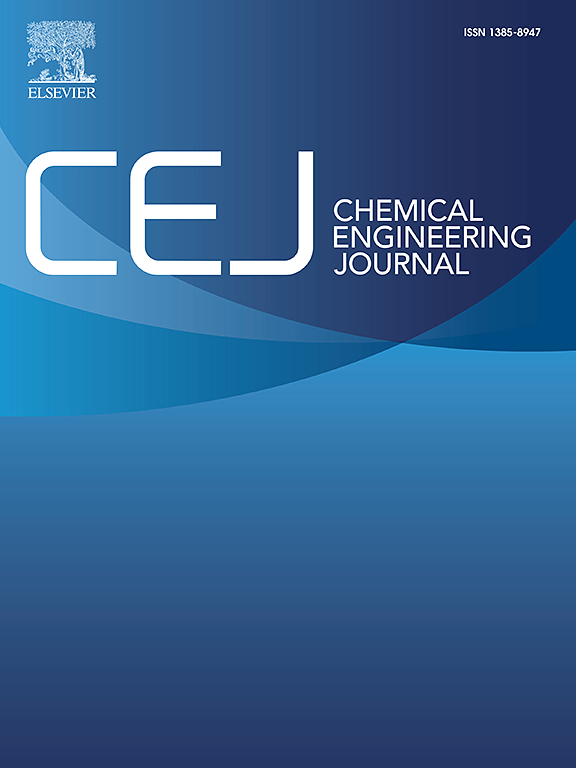Closed-loop upcycling of sewage sludge products into sp2-C-rich electrodes for pollutant oxidation: tracking mineralization by 14C-labeling
IF 13.3
1区 工程技术
Q1 ENGINEERING, CHEMICAL
引用次数: 0
Abstract
To address the need for sustainable wastewater treatment, we developed sp2‑carbon-rich, hierarchically porous electrodes by upcycling sewage sludge ash (SSA) and biochar (CB) using a hybrid 3D printing and microwave plasma-enhanced chemical vapor deposition (MPECVD) approach. The CB-containing electrode exhibited a 260-fold increase in BET surface area (0.15 to 40.6 m2 g−1), but the lowest electrochemically active surface area (EASA = 18.3 cm2 g−1), indicating limited site accessibility. In contrast, SSA-based electrodes offered both higher BET and EASA values (up to 328.6 cm2 g−1), improving adsorption and oxidation performance.Electrochemical oxidation of 14C-labelled micropollutants (BPA, diclofenac, carbamazepine, and PFOA) exhibited pollutant-specific removal pathways. SSA electrodes enhanced BPA adsorption and mineralization, achieving a 1.6-fold faster CO₂ production rate. While CBZ and DIC were partially mineralised, no measurable CO₂ formation was observed for PFOA, suggesting a different removal mechanism. An inverse correlation was observed between mineralization rates and DFT-calculated bond cleavage energies. These findings highlight the practical potential of upcycled electrodes to achieve efficient mineralization of persistent organic pollutants. This closed-loop strategy offers an environmentally viable approach to turning waste into functional materials for advanced wastewater treatment processes.

污水污泥产品闭环升级循环成富sp2- c电极用于污染物氧化:通过14c标记跟踪矿化
为了满足可持续废水处理的需求,我们采用3D打印和微波等离子体增强化学气相沉积(MPECVD)混合方法,通过升级回收污水污泥灰(SSA)和生物炭(CB),开发了富含sp2碳的分层多孔电极。含cb电极的BET表面积增加了260倍(0.15 ~ 40.6 m2 g−1),但电化学活性表面积最低(EASA = 18.3 cm2 g−1),表明可达性有限。相比之下,ssa电极提供了更高的BET和EASA值(高达328.6 cm2 g−1),改善了吸附和氧化性能。电化学氧化14c标记的微污染物(BPA、双氯芬酸、卡马西平和PFOA)表现出污染物特异性去除途径。SSA电极增强了BPA的吸附和矿化,使CO₂的产出率提高了1.6倍。虽然CBZ和DIC部分矿化,但PFOA未观察到可测量的CO₂形成,表明不同的去除机制。矿化率与dft计算的键解理能呈负相关。这些发现强调了升级回收电极在实现持久性有机污染物有效矿化方面的实际潜力。这种闭环策略提供了一种环保可行的方法,将废物转化为高级废水处理工艺的功能材料。
本文章由计算机程序翻译,如有差异,请以英文原文为准。
求助全文
约1分钟内获得全文
求助全文
来源期刊

Chemical Engineering Journal
工程技术-工程:化工
CiteScore
21.70
自引率
9.30%
发文量
6781
审稿时长
2.4 months
期刊介绍:
The Chemical Engineering Journal is an international research journal that invites contributions of original and novel fundamental research. It aims to provide an international platform for presenting original fundamental research, interpretative reviews, and discussions on new developments in chemical engineering. The journal welcomes papers that describe novel theory and its practical application, as well as those that demonstrate the transfer of techniques from other disciplines. It also welcomes reports on carefully conducted experimental work that is soundly interpreted. The main focus of the journal is on original and rigorous research results that have broad significance. The Catalysis section within the Chemical Engineering Journal focuses specifically on Experimental and Theoretical studies in the fields of heterogeneous catalysis, molecular catalysis, and biocatalysis. These studies have industrial impact on various sectors such as chemicals, energy, materials, foods, healthcare, and environmental protection.
 求助内容:
求助内容: 应助结果提醒方式:
应助结果提醒方式:


